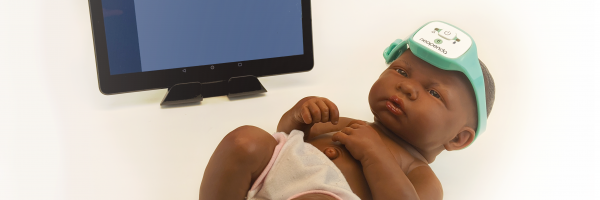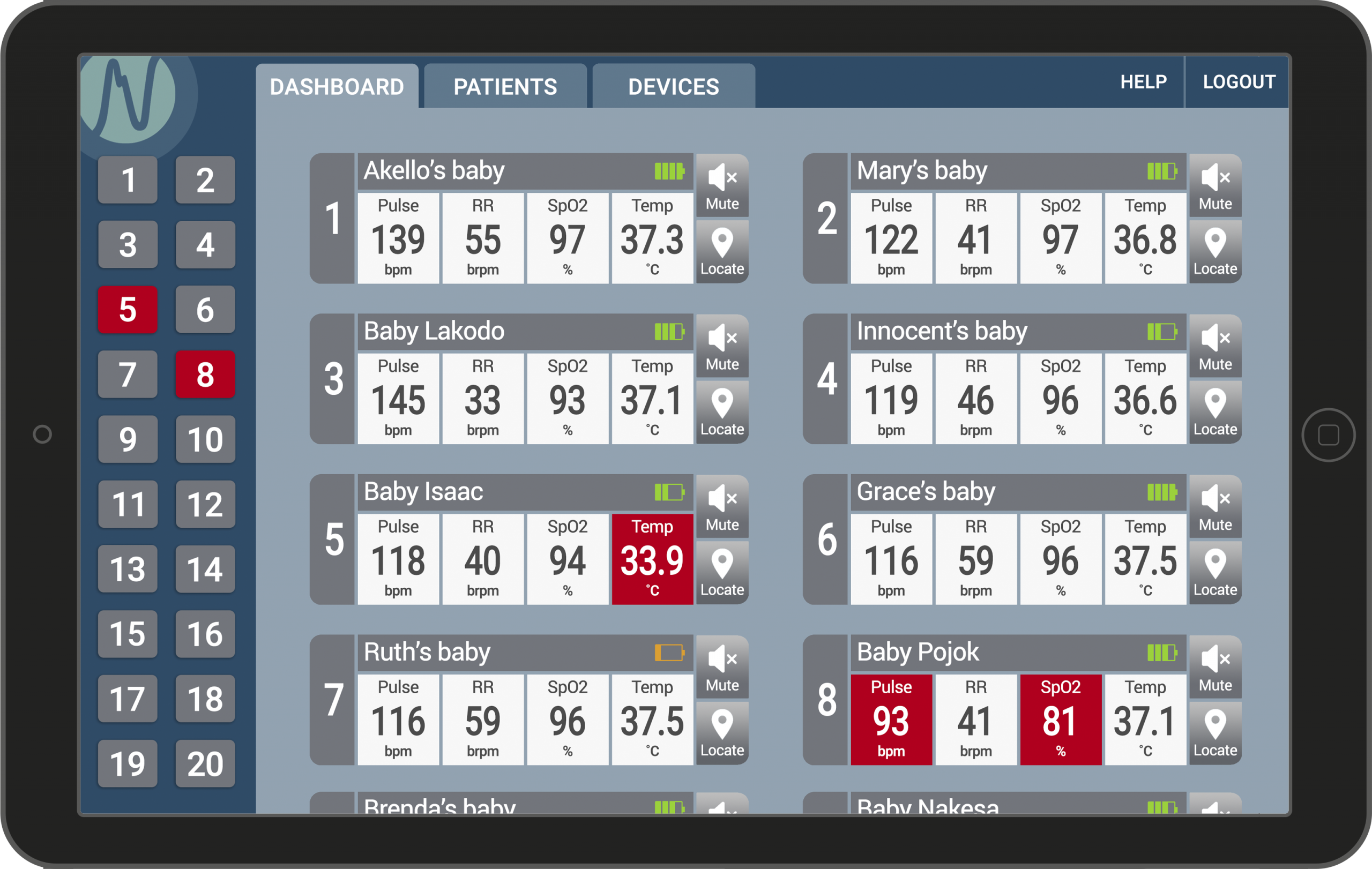
Neopenda is a social enterprise startup that is passionate about improving newborn health through innovative technology solutions. Neopenda won the Cisco Global Problem Solver Prize at the 2016 Rice Business Plan Competition for the development of a low-cost, wearable sensor that improves the care of newborns in resource-constrained hospitals. neoGuard continuously monitors newborns’ critical vital signs and alerts attending health care professionals when a baby is in distress.
Sona Shah, co-founder and CEO of Neopenda, began her path to global health entrepreneurship after she earned a bachelor’s degree in chemical engineering from Georgia Tech. Sona subsequently worked as an engineer in Bioprocess Research and Development at Eli Lilly and Company. She followed her passion for service to Kenya, spending time as a teacher and an Engineering Without Borders volunteer. She also worked at the T.B. Alliance, both in community engagement and drug discovery, for medications that treat tuberculosis. Sona completed a master’s degree in biomedical engineering at Columbia University before launching Neopenda. Now she develops health care solutions for the world’s most vulnerable populations. She recently shared with us how neoGuard is being used on neonatal, pediatric, and adult patients to help monitor their health during the COVID-19 pandemic.
How did winning the Cisco Global Problem Solver prize help you and your team?
The funding itself was instrumental when we first received it because it enabled us to create additional prototypes to go through the design and iteration process. It was nice to have that vote of confidence that what we are doing matters. Beyond the actual funding piece itself, having Cisco’s support helped us in many different ways. It enabled us to get additional funding, as well as mentions in a variety of news articles. It is incredible how much the funding that they gave us early on jumpstarted all of our activities, so we’re very much appreciative of our relationship with Cisco.
neoGuard was initially developed to help monitor vital signs in infants. Can you tell us more about the milestones you have gone through in the past few years?

Since we won the Cisco Global Problem Solver Prize in 2016, we’ve been through three major design iterations of the product, with iterative feedback from more than 400 stakeholders throughout Uganda. We have hired additional team members to support our efforts. In Q4 2019, we transferred the design over to our manufacturer in Malaysia and completed a pilot build with our contract manufacturer. We completed several clinical trials on neonatal patients both in the United States and in Uganda, and were preparing to launch neoGuard in Uganda. In light of the COVID-19 pandemic, we decided to get in the fight. To meet the growing demand for vital signs monitoring equipment during the crisis, we have modified neoGuard for use on neonatal, pediatric, and adult patients alike. We are rapidly adapting our solution and scaling up to mass production to help fill the demand we are seeing for neoGuard.
How did you shift neoGuard to also monitor pediatrics and adults?
It was always our intention to create a product that was applicable to any patient population. We started with neonates because they’re one of the most vulnerable patient populations and are often forgotten. We had always intended to adapt for pediatric and adult patients. Still, we wanted to do that in 2021 for pediatric and 2022 for adults. When the pandemic hit, we realized that neoGuard could help. Given that COVID-19 affects mostly adult patients, we started thinking, can we expedite our development process to adapt neoGuard for adult patients on a more immediate timeline? After doing our internal testing, we realized that it was possible.
What type of environment is the best use for neoGuard?
In the United States, we’re adapting our solution to remotely monitor patients recovering at home. Telehealth has been up-and-coming for several years now. Still, I think it’s going to become even more prevalent with the pandemic. We’re doing a pilot study with a hospital in Hawaii, where we are monitoring patients remotely. Patients who are recovering from COVID-19 at home can relay their vital signs back to clinicians to help them understand if the treatment is working. Healthcare teams can also receive updates if patients are progressing or if they need to alter therapy in any way. Internationally it’s still the same focus that we were thinking about previously. Hospitals are still resource-constrained, even for adult patient populations, and continuous monitoring of patients is not common. While we pivoted slightly from our use case of just neonates and have adapted it for adults, we’re still looking at monitoring patients within the health facilities. We are also considering additional use cases, such as nursing homes, refugee camps, and community health workers.
How are you hoping neoGuard will help hospitals and clinicians fight COVID-19?

There are three main ways that vital signs monitoring is essential in the care of patients with COVID-19 and other emerging diseases. The first way is to help identify patients at risk. While neoGuard is certainly not a diagnostic, some of the symptoms that are common in COVID-positive patients are an elevated respiratory rate and elevated temperature. Both of those are symptoms that we measure with our device. Still, our device can help identify some of those at-risk patients to help clinicians determine which patients should get tested.
The second way is helping clinicians know what treatment to give. Vital signs are indicators of disease progression and the health status of the patient; healthcare workers review them to gain a better understanding of which direction the care should go in. Should we put the patient on oxygen? Should we put them on a ventilator? What type of therapy should we give to patients, and how far along is their disease progression? Vital signs monitoring can help enable clinical decision making.
The third way it is to help guide therapy for patients. Are patients getting better, is the treatment working? Pulse oximetry is very relevant for this case. Just being able to monitor their oxygen saturation is essential throughout the disease progression and helps indicate whether treatment is working or not. The World Health Organization has listed pulse oximeters as critical equipment in the COVID response.
We’re thrilled that neoGuard can help during this pandemic and in the future.
Have there been opportunities to collaborate with others?
I’m very impressed with how well the global community is springing into action. I think people are looking for immediate ways to partner with each other to help combat the pandemic. We’ve been able to bring on several additional partners–from financing to pro-bono support to implementation partners. We’ve been very fortunate to have several individuals and organizations volunteer their time to help us rapidly adapt to adult patient populations.
How are you going to raise funds to mass-produce neoGuard?
We are doing a crowdfunding campaign through GoFundMe. The intention is two-fold. One is to get the word out about our ability to support the COVID response and find additional partners that want to support our efforts and/or need our solution. Second is the actual funding piece of it, which we need to be able to respond quickly. We are raising a larger seed round, but investment rounds naturally take time to raise given the diligence process. So, we’re doing a crowdfunding campaign to help bridge that gap and expedite our efforts.
What are your plans for the future for Neopenda and your first device, neoGuard?
For neoGuard, we are going to market with the adult, pediatric, and neonatal versions, just on an expedited timeline to help in the current pandemic. We are launching in Uganda to start with and then rapidly scaling to other countries. We will demonstrate the applicability of our vital signs monitor in a variety of use cases, both within and outside of health facilities. Ultimately, we will leverage our expertise in designing and implementing medical devices for future pipeline products as well.



Amazing, cannot wait to see this available in the US and UK